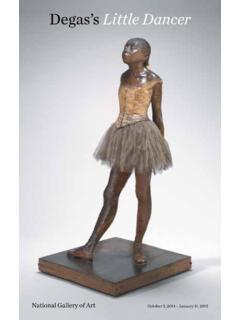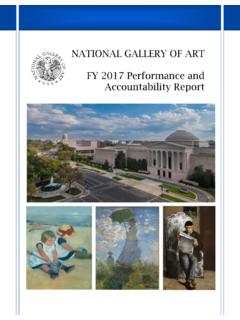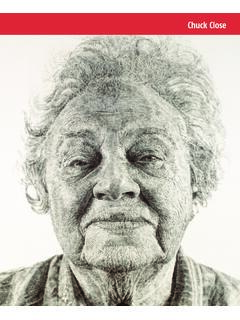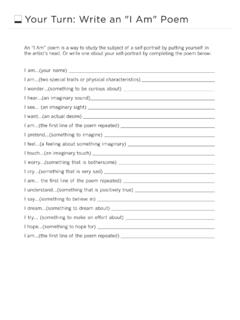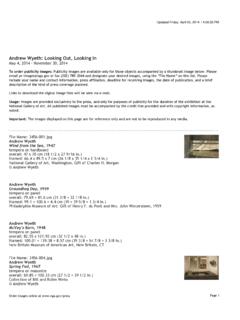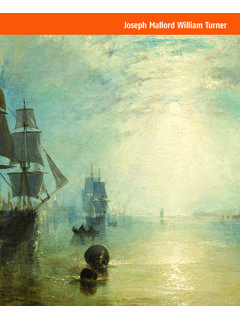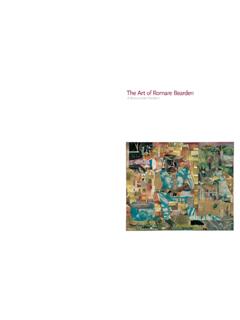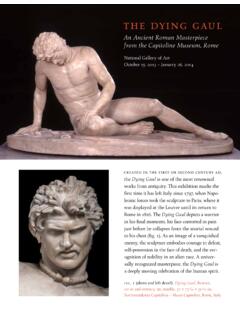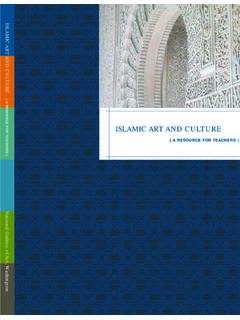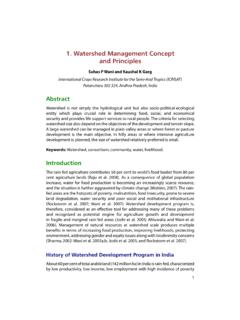Transcription of N at i o N a l G a l l e r y o f a r t | D i v i s i o N o ...
1 Painting in the Dutch Golden Age A Profile of the Seventeenth CenturynAt i o nAl G Al l e r y o f Ar t , wA Sh i nGt o nN a t i oNa l G a l l e r y o f ar t | D i v i s i oN o f e Du c a t i oND e p a r t m eNt o f e Du c a t i oN pu b l i c a t i oNsPainting in the Dutch Golden Agea profile of the seventeenth centuryN a t i oNa l G a l l e r y o f ar tW a s h iN Gt oNPainting in the Dutch Golden AgeA Resource for TeachersPainting in the Dutch Golden AgeA Profile of the Seventeenth CenturyNational Gallery of Art, WashingtonAcknowledgmentsThis teaching packet is a project of the National Gallery of Art, department of education publica-tions. Writers Carla Brenner, Jennifer Riddell, and Barbara Moore extend sincere thanks to colleagues at the Gallery: curator of northern baroque paint-ings Arthur Wheelock, exhibition research assistants Jephta Dullaart and Ginny Treanor, and curatorial assistant Molli Kuenstner, who generously shared books and expertise; head of the education divi-sion Lynn Pearson Russell; editor Ulrike Mills and designer Chris Vogel; and fellow staff members Ira Bartfield, Barbara Bernard, Ricardo Blanc, Bob Grove, Peter Huestis, Greg Jecmen, Leo Kasun, Yuri Long, Donna Mann, Marjorie McMahon, Rachel Richards, Carrie Scharf, Neal Turtell, and Barbara Woods.
2 We also thank our colleague Anna Tummers, lecturer in art history, University of Amsterdam, for her original manuscript, sustained collaboration, and precise editorial comments, which have nurtured this book to its final form. 2007 Board of Trustees, National Gallery of Art, Wash i ng toncover and frontispiecefront cover: Jan Davidsz de Heem, Dutch, 1606 1683/1684, Vase of Flowers (detail), c. 1660, oil on canvas, = (273 8 = 22 ), National Gallery of Art, Washington, Andrew W. Mellon Fundback cover: Frans Hals, Dutch, c. 1582/1583 1666, Willem Coymans (detail), 1645, oil on canvas, 77 = 64 (30 = 25), National Gallery of Art, Washington, Andrew W. Mellon Collectionfrontispiece: Ludolf Backhuysen, Dutch, 1631 1708, Ships in Distress off a Rocky Coast (detail), 1667, oil on canvas, = (45 = 657 8), National Gallery of Art, Washington, Ailsa Mellon Bruce Fund6 How to Use This Book7 MapSection 18 Profile of the Dutch Republic12 In Focus: A Dutch Stalwart18 In Focus: Armada for Independence24 Feature: America s Dutch HeritageSection 231A Golden Age for the Arts33 Feature: Inside Dutch Paintings36 In Focus: A Life in Balance42 In Focus: The True Leading StarSection 344 Life in the City and Countryside48 In Focus: Inside Dutch Churches52 Feature: A Vegetable Market60 In Focus: Love and Foolishness64 In Focus: Country Estates and Manors66 Feature.
3 Dutch DishesSection 468 Landscape Painting70 In Focus: Landscapes of HarmonySection 576 Genre Painting78 In Focus: Subtleties and Ambiguities84 In Focus: The Poetry of Everyday SubjectsContentsSection 686 Still-Life Painting90 In Focus: Luxury and Lessons92 Feature: Flowers and Flower Painting94 In Focus: A Full Bouquet Section 796 Portraiture100 In Focus: A Learned Maid 112 Feature: Rembrandt Self-PortraitsSection 8116 History Painting118 In Focus: Moses and the Dutch122 In Focus: A Moment of Moral DilemmaSection 9124 Talking about PicturesSection 10130 Dutch Artists of the Seventeenth Century155 Chronology156 Resources, Print and Online159 List of Slides and Reproductions161 GlossaryHow to Use This Book This book is one component of the Painting in the Dutch Golden Age teaching packet.
4 Other elements include: twenty slides twelve 11 x 14 color reproductions cd with jpeg image files of every National Gallery work of art reproduced here separate classroom activity guideDimensions of works of art are given in centimeters followed by inches; height precedes book introduces teachers of middle school stu-dents and up to seventeenth-century Dutch culture and its early influence in North America. Three introductory chapters, Profile of the Dutch Repub-lic, A Golden Age for the Arts, and Life in the City and Countryside, provide an overview. Next are five sections on the types of painting strongly associated with Dutch art of the Golden Age: Land-scape Painting, Genre Painting, Still-Life Paint-ing, Portraiture, and History Painting.
5 Dutch paintings of the time presumably offer snapshots of what Dutch life was like, but in fact they contained an equal measure of reality and artifice. Dutch artists broke with conventions and took liberties to create images that reflected their republic s socially conser-vative, yet worldly, aspirations. The result was a vast body of work enormously original in approach and varied in subject artists also continued efforts, begun during the Renaissance, to elevate the status of art beyond its associations with lesser trades and to restructure the guild system. Patrons and artists discussed the fine points of composition, technique, and ways in which art engaged the attentions of the viewer. This connoisseurship (addressed in the section Talking about Pictures ) spurred the found-ing of specialized art academies and a new business of art.
6 Within the chapters, In Focus sections look more deeply at individual works in the National Gallery of Art s collection. These discussions crystal-lize key chapter concepts. You will also find multi-page special-topic features that address such subjects as America s Dutch Heritage and Flowers and Flower Painting. The book also includes a timeline, a listing of resources, both printed and online, and a glossary. We hope you find this packet a useful resource for engaging students on such subjects as world his-tory, the founding of the United States, visual and cultural analysis, geography, world religion, and social studies. We welcome your comments and questions. Please contact us at: Department of Education PublicationsNational Gallery of Art, Washingtonmailing address2000B South Club DriveLandover, MD 20785(202) HagueDelftLeidenUtrechtDeventer RotterdamDordrechtBredaMiddelburgZwolleG roningenGoudaKampen s-HertogenboschAntwerp Cologne HOLLANDNORTH HOLLANDUTRECHTGELDERLANDOVERIJSSELFRIESL ANDGRONINGENDRENTHENORTH BRABANTLIMBURGFLEVOLANDRijn (Rhine)
7 river Lek river Maas RiverAfsluitdijkWest Frisian IslandsMarkerwaarddijk BELGIUMGERMANYTHE NETHERLANDSNORTH SEAIJSSELMEERThe Netherlands TodaySECTION 1 Profile of the Dutch Republic For the Netherlands, the seventeenth century was a period of remarkable prosperity and artistic output a true Golden LAND OF WIND AND WATERT here is a saying that God created the world but the Dutch made the Netherlands. The very word Netherlands means low lands. The country is located on the North Sea, and large areas lie below sea level; its lowest point is more than 22 feet below sea level and its highest only about 1,050 feet above. The nation s geography has shaped its history and culture. Through the centuries, the Dutch have prevailed against the sea by hard work and constant vigilance, yet water and ocean winds have also been a boon, resources that played a key part in the success of the Netherlands in the seventeenth seas were drained to reclaim land, creating new arable areas called polders, a process begun in the 1200s to accommodate a growing population.
8 Between 1590 and 1650, the area of northern Holland increased by one-third, and land reclamation projects continued through the seventeenth century. They were large-scale and costly ventures, often financed by selling shares. Arent Arentsz, called Cabel, Dutch, 1585/1586 1631, Polderlandscape with Fisherman and Peasants, 1625/1631, oil on panel, = (10 = 197 8), Rijksmuseum, AmsterdamJan van Goyen, Dutch, 1596 1656, View of Dordrecht from the Dordtse Kil (detail), 164 4, oil on panel, = (25 = 37 ), National Gallery of Art, Washington, Ailsa Mellon Bruce Fund9 WindmillsProbably nothing is more emblematic of the Neth-erlands than the windmill. Today just under a thou-sand survive; at one time there were probably some nine thousand.
9 In the seventeenth century they powered a range of activities, from grinding grain and mustard to sawing timber and processing paint. Until fairly recent times they still regulated inland water levels. The mill in the etching seen here is a smock mill (named because it was thought to resemble a smock). Smock mills took many different forms. This one is a top-wheeler: to angle the sails so they could capture the wind, the miller only had to rotate the cap where the sails are attached. Top-wheeling mills were invented during the 1300s. Rembrandt van Rijn s painting (p. 13) shows a post mill, a type of mill already in use around 1200. The sails are supported on a boxlike wooden structure that rests on a strong vertical post. Carefully balanced on a revolving plat-form, the entire upper structure is turned so that the sails can catch the wind.
10 A miller could communicate various messages by setting the idle sails of a mill in different posi-tions. As late as World War II, prearranged sail signals warned of Nazi raids and urged townspeople into hiding. Rembrandt van Rijn, Dutch, 1606 1669, The Windmill, 1641, etching, = (5 = 81 8), National Gallery of Art, Washington, Gift of Russell Allen 10 WorkingLightning made it inadvisable to leave a sail in the full vertical position for long periods. If a potential customer found an idle sail upright, he could assume that the miller would likely soon return. (Today, after installation of lightning conductors, sails rest-ing in this configuration are commonly seen.)MourningThe departing sail, by contrast, stopped just after passing the lowest point, communicated most parts of the Netherlands sails were set in this position to share the news when a miller s family cel-ebrated births, weddings, or other happy occasions.
